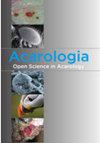Four hundred and sixty-two mites for the ride: the phoretic companions of a historical Nicrophorus specimen (Coleoptera, Silphidae)
IF 0.9
3区 农林科学
Q3 ENTOMOLOGY
引用次数: 0
Abstract
Burying beetles (Silphidae) and mites (Acari) have a well-established mutualistic interaction, and the phoretic mites will accompany their host even after its death. A voucher specimen of Nicrophorus vespillo (L., 1758) housed in the historical collection at the Oxford University Museum of Natural History (OUMNH) was examined for its 456 plus phoretic mites, which were carefully glued to cardboard slides and preserved together with the beetle carrier. Due to the fragility of the samples, only the Mesostigmata mites were prepared for mounting and further species identification. With the addition of 6 hypopi of Histiostomatidae, a total of 462 mites were identified. Four hypopi were found attached on the Parasitidae dorsal shields and two glued to the cardboard surface. The remaining 456 were composed of 445 specimens of two populations of Poecilochirus carabi Canestrini and Canestrini, 1882 (Parasitidae), and 11 specimens identified as two populations of Macrocheles nataliae Bregetova et Koroleva, 1960. We discuss the interaction and diversity of the numerous mites recorded on a single N. vespillo host. We propose that the presence of different populations of phoretic mites on a single carrier is beneficial to the mites, increasing their chances of outbreeding, adding to their genetic diversity. This study reports a new record of Acari-to-Acari hyperphoresy.四百六十二个小螨虫:一个历史上的微蚁标本的语音同伴(鞘翅目,Silphidae)
埋虫(Silphidae)和螨虫(Acari)已经建立了一种互惠互利的互动关系,即使在宿主死后,埋虫也会陪伴在宿主身边。在牛津大学自然历史博物馆(OUMNH)的历史收藏中,对一件维斯皮略微孔虫(L., 1758)的代金券标本进行了检查,发现了456多只微孔虫,这些微孔虫被小心地粘在纸板上,与甲虫载体一起保存起来。由于样品的易碎性,只准备了中柱头螨进行安装和进一步的物种鉴定。再加上6只组织口螨,共鉴定螨类462只。发现有4只寄生在背盾上,2只粘在纸板表面。其余456份标本由1882年寄生蜂科(Poecilochirus carabi Canestrini和Canestrini) 2个居群的445份标本和11份鉴定为Macrocheles nataliae 2个居群的标本组成。我们讨论了在一个单一的N. vespillo宿主上记录的众多螨的相互作用和多样性。我们提出,在一个载体上存在不同种群的传粉螨对螨虫是有益的,增加了它们近亲繁殖的机会,增加了它们的遗传多样性。本研究报告了一个新的记录,螨对螨的变态。
本文章由计算机程序翻译,如有差异,请以英文原文为准。
求助全文
约1分钟内获得全文
求助全文
来源期刊

Acarologia
ENTOMOLOGY-
CiteScore
2.00
自引率
18.20%
发文量
81
期刊介绍:
Acarologia is a free open-access journal. Please help us by submitting manuscripts in accordance with following instructions.
All manuscripts which do not conform to the instructions will be returned to authors without the benefit of review.
Acarologia publishes the results of original research on all aspects of Acarology.
The journal policy is that taxonomic descriptions should include several species within a same genus/family, when possible.
The editors reserve the right to refuse manuscripts when authors intentionally divide individual species descriptions of the same genus/family into distinct publications.
Single species descriptions should be clearly justified based on their scientific interest.
 求助内容:
求助内容: 应助结果提醒方式:
应助结果提醒方式:


